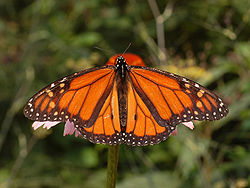

This article is about the butterfly. For the historical Royal Navy rank see Admiral (United Kingdom) or Post-Captain.
The Yellow or Australian Admiral (Vanessa itea) is a butterfly endemic to Australia, New Zealand, and Lord Howe and Norfolk Islands. The Māori name is kahukowhai, which means "yellow cloak". The Yellow Admiral is a member of the family Nymphalidae, the sub-family Nymphalinae as well as the tribe Nymphalini.
It prefers open country, wastelands and gardens where the nettles, Urtica incisa and Urtica urens are present. These are the main food plants for the larvae.
The Yellow Admiral with a wingspan of 48 to 55 mm and is a strong flier, and is believed to survive wind-blown travel from Australia to New Zealand.
Yellow Admirals occur most frequently during summer and may live for several months. The adults feed on nectar from any available flowers.
Yellow Admirals are relatively common throughout their range wherever their food plants occur.
TITLE DEED
MONARCH
There is no clear definition of monarchy. Holding unlimited political power in the state is not the defining characteristic, as many constitutional monarchies such as the United Kingdom and Thailand are considered monarchies. Hereditary rule is often a common characteristic, but elective monarchies are also considered monarchies (the pope, sovereign of the Vatican City State, is elected by the College of Cardinals) and some states have hereditary rulers, but are considered republics (such as the stadtholder of the Dutch Republic, or the Great Council of Chiefs in Fiji).[1] A 1914 edition of Bouvier's Law Dictionary states that "Monarchy is contradistinguished from republic," and gives this definition:
Arches were known by the Mesopotamian Urartian, Harappan, Egyptian, Babylonian, Greek and Assyrian civilizations, but their use was infrequent and mostly confined to underground structures such as drains where the problem of lateral thrust is greatly diminished. The oldest arched city gate in the world, eight feet wide, was found in Ashkelon, Israel, and is dated to the middle bronze age.
An architect is trained and licensed in planning and designing buildings, and participates in supervising the construction of a building. Etymologically, architect derives from the Latin architectus, itself derived from the Greek arkhitekton (arkhi-, chief + tekton, builder), i.e. chief builder. [2] A looser usage of Architect is: the translator of the building user's requirements of and from a building into an inhabitable environment. Moreover, the words architect and architecture are used in the disciplines of engineering, e.g. computer software architect; however, in some of the world's jurisdictions, the professional and commercial uses of these etymologic variants, are legally protected from such loose denotations.
Professionally, an architect's decisions affect public safety, and thus must undergo specialized training and education, and a practicum for practical experience in order to qualify for and earn a licence to practice architecture; the practical, technical, and academic requirements for being a licenced architect vary (see below).
| Siberian Tiger Simplified Chinese: 东北虎 Chinese: 東北虎 Russian: Амурский тигр Mongolian: Сибирийн бар Persian: ببر سیبری Korean: 시베리아호랑이 |
||||||||||||||||||
|---|---|---|---|---|---|---|---|---|---|---|---|---|---|---|---|---|---|---|
 |
||||||||||||||||||
| Conservation status | ||||||||||||||||||
| Scientific classification | ||||||||||||||||||
|
||||||||||||||||||
| Trinomial name | ||||||||||||||||||
| Panthera tigris altaica Temminck, 1884 |
||||||||||||||||||
 Distribution of the Siberian tiger (in red)
|
||||||||||||||||||
 Original western distribution of the Siberian tiger (in red)
|
||||||||||||||||||
| Synonyms | ||||||||||||||||||
|
P. t. virgata (Iran, Iraq, Afghanistan, Turkey, Mongolia, Caucasus, Tajikistan, Turkmenistan, and Uzbekistan) |
The Siberian tiger (Panthera tigris altaica) is also known as the Amur, Manchurian, Altaic, Korean, North China or, Ussuri tiger. Though it once ranged throughout Western and Central Asia and eastern Russia it is now completely confined to the Amur-Ussuri region of Primorsky Krai and Khabarovsk Krai in far eastern Siberia, where it is now protected. It is considered to be the biggest of the nine recent tiger subspecies and the largest living felid.[2] Genetic research in 2009 revealed that the current Siberian tiger population is almost identical to the Caspian tiger, a now extinct western population once thought to have been a distinct subspecies.[3]
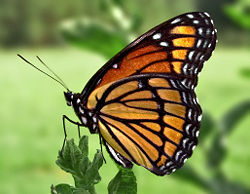
The Viceroy Butterfly (Limenitis archippus) is a North American butterfly with a range from the Northwest Territories along the eastern edges of the Cascade Range and Sierra Nevada mountains, southwards into central Mexico.
Its wings feature an orange and black pattern, and over most of its range it is a Müllerian mimic[1] with the Monarch Butterfly (Danaus plexippus). In Florida, Georgia, and the Southwest, Viceroys share the pattern of the Queen Butterfly (Danaus gilippus) and in Mexico they share the pattern of the Soldier Butterfly (Danaus eresimus). In all three areas, the Viceroy populations mimic the coloration of the local Danaus species. It was originally believed that the Viceroy was a Batesian mimic of the three other species, in that it was presumably edible or only mildly unpalatable to predators, but this has since proven not to be true.
The caterpillar feeds on trees in the willow family Salicaceae, including willows (Salix), and poplars and cottonwoods (Populus). The caterpillars sequester the salicylic acid in their bodies, which makes them bitter, and upsets predators' stomachs. As further protection, the caterpillars, as well as their chrysalis stage, resemble bird droppings. Adults are strictly diurnal, they fly preferentially in the late morning and early afternoon.[2]
The Viceroy was named the state butterfly of Kentucky in 1990.
TITLE DEED
MONARCH MATTRESS
Farmer's has an 'exclusive' arrangement with the Chinese company (owned by Baker) to sell Monarch brand 'innerspring' mattresses.
_________________________________________
Monarch Mattress Mfg.
Contact Information about Monarch Mattress Mfg. Co.
Get Free Quote / Samples / Send RFQ:
| Address: |
1519 Wyandotte St E Windsor, ON, N9A 3L3 |
|---|---|
| Phone: | 519-252-8329 |
| Fax: | 519-252-1051 |


| Tiger | ||||||||||||||
|---|---|---|---|---|---|---|---|---|---|---|---|---|---|---|
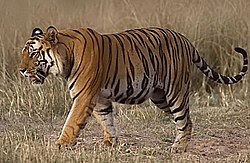 A Bengal Tiger (P. tigris tigris) in India's Bandhavgarh National Park.
|
||||||||||||||
| Conservation status | ||||||||||||||
| Scientific classification | ||||||||||||||
|
||||||||||||||
| Binomial name | ||||||||||||||
| Panthera tigris (Linnaeus, 1758) |
||||||||||||||
![Historical distribution of tigers (pale yellow) and 2006 (green).[2]](http://upload.wikimedia.org/wikipedia/commons/thumb/c/c8/Tiger_map.jpg/250px-Tiger_map.jpg) Historical distribution of tigers (pale yellow) and 2006 (green).[2]
|
||||||||||||||
| Subspecies | ||||||||||||||
|
P. t. bengalensis |
||||||||||||||
| Synonyms | ||||||||||||||
|
Tigris striatus Severtzov, 1858 |
The tiger (Panthera tigris) is a member of the Felidae family; the largest of the four "big cats" in the genus Panthera.[4] Native to much of eastern and southern Asia, the tiger is an apex predator and an obligate carnivore. Reaching up to 4 metres (13 ft) in total length and weighing up to 300 kilograms (660 pounds), the larger tiger subspecies are comparable in size to the biggest extinct felids.[5][6] Aside from their great bulk and power, their most recognizable feature is the pattern of dark vertical stripes that overlays near-white to reddish-orange fur, with lighter underparts. The largest subspecies of tiger is the Siberian tiger.
Highly adaptable, tigers range from the Siberian taiga, to open grasslands, to tropical mangrove swamps. They are territorial and generally solitary animals, often requiring large contiguous areas of habitat that support their prey demands. This, coupled with the fact that they are endemic to some of the more densely populated places on earth, has caused significant conflicts with humans. Of the nine subspecies of modern tiger, three are extinct and the remaining six are classified as endangered, some critically so. The primary direct causes are habitat destruction and fragmentation, and hunting. Their historical range, which once reached from Mesopotamia and the Caucasus through most of South and East Asia, has been radically reduced. While all surviving species are under formal protection, poaching, habitat destruction and inbreeding depression continue to be threats.
Nonetheless, tigers are among the most recognizable and popular of the world's charismatic megafauna. They have featured prominently in ancient mythology and folklore, and continue to be depicted in modern films and literature. Tigers appear on many flags and coats of arms, as mascots for sporting teams, and as the national animal of several Asian nations.
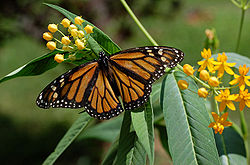
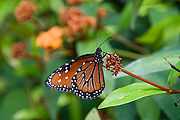
The Queen Butterfly (Danaus gilippus) is a North and South American butterfly in the family Nymphalidae (the brush-foots) with a wingspan of 2.75–3.25" (70–88mm). It is orange or brown with black wing borders and small white forewing spots on its dorsal wing surface, and reddish ventral wing surface fairly similar to the dorsal surface. The ventral hindwings have black veins and small white spots in a black border. The male has a black androconial scent patch on its dorsal hindwings.
This species is possibly a close relative to the similarly-colored Soldier Butterfly (or "Tropic Queen"; Danaus eresimus); in any case, it is not close to the Plain Tiger (Danaus chrysippus) as was long believed. There are about 10 recognized subspecies (Smith et al. 2005). As with other North American Danaus species, it is involved in Müllerian mimicry with the Viceroy butterfly (Limenitis archippus) where the two co-occur.
TITLE DEED
MONARCH TENNIS RACQUET
http://shop.ebay.com/items/?_nkw=tennis+racquet+wooden&_armrs=1&_from=&_ipg=&_sop=12
 |
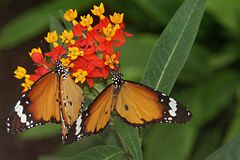
The Plain Tiger (Danaus chrysippus) or outside Asia, African Monarch, is a common butterfly which is widespread in Asia and Africa. It belongs to the Danainae ("Milkweed butterflies") subfamily of the brush-footed butterfly family, Nymphalidae.
It is believed to be one of the first butterflies to be used in art. A 3500 year old Egyptian fresco in Luxor features the oldest illustration of this species.[1]
The Plain Tiger can be considered the archetypical danaine of India. Accordingly, this species has been studied with in greater detail than other members of its subfamily occurring in India.
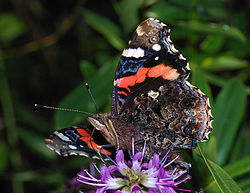
The Red Admiral or Vanessa atalanta (previously also known as Pyrameis atalanta) is a well-known colourful butterfly, found in temperate Europe, Asia and North America. The species is resident only in warmer areas, but migrates north in spring, and sometimes again in autumn.
This large butterfly is identified by its striking dark brown, red and black wing pattern. The caterpillar feeds on nettles, and the adult drinks from flowering plants like the Buddleia and overripe fruit.
In northern Europe, it is one of the last butterflies to be seen before winter sets in, often feeding on the pale fire of ivy flowers on sunny days. The Red Admiral is also known to hibernate, re-emerging individuals showing prominently darker colourings than first brood subjects. The butterfly also flies on sunny winter days, especially in southern Europe.
In North America, the Red Admiral generally has two broods from March through October. Most of North America must be recolonized each spring by southern migrants, but this species over-winters in south Texas.
